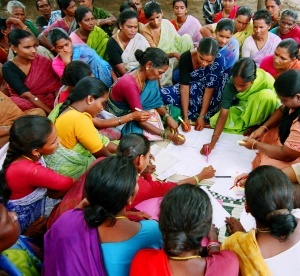When communities pull together to solve problems, it rarely makes headlines (especially in developing countries) but this month such an example did draw media attention, along with an international event spotlighting community philanthropy.
Earlier in July, America Abroad featured a story of a Kenyan community’s success managing a water crisis with local assets. (Listen to Kenyan communities succeed in managing scarce water, where aid projects once foundered.) The program heard on National Public Radio (NPR) captures how local ownership created a long-term solution; that in turn bloomed into other improvements, with road access and education. As David Clatsworthy of the International Rescue Committee notes, “It’s obviously much better when the community starts out with that sense of ownership … So it would be great if this was a model that spread virally.” The Global Alliance for Community Philanthropy (GACP), established last year, works to achieve this type of exponential spread.
Introducing the Global Alliance for Community Philanthropy
On July 9, we joined with our Global Alliance partners, including the C.S. Mott Foundation, the U.S. Agency for International Development, and the Rockefeller Brothers Fund, at a lunchtime talk that showcased a wide range of community philanthropy experience from around the world.
Held at the World Bank’s Washington, DC offices, the panel discussion was titled “Community Philanthropy’s Role in Sustaining Development: Development’s Role in Supporting Community Philanthropy.” It featured experiences from Ireland, Haiti, and across the Aga Khan Development Network (AKDN). The stories described community-led initiatives strengthened by select international support, in some cases going back more than 30 years.

Community investment and sense of ownership is a key factor in sustainable development.
Role in Improving Development
“How can community-driven development play a role in enhancing the development outcomes of big international donor aid?” asked Jenny Hodgson, Executive Director of the Global Fund for Community Foundations, which serves as the secretariat for the Global Alliance. In response, three main themes emerged from the panel.
First, there’s a need for local voices and there must be space for local actors to play a role in development planning and decisions. Dr. Mirza Jahani, former CEO of AKF USA, noted how AKDN’s first rural support programs are rooted in this community-driven approach, empowering isolated communities to make decisions about their own development. When you build on local assets and local traditions of self-help, he added, “you have a much stronger chance for sustainability.” The practice of community philanthropy is not new around the world, and “has been there throughout history.”
Second, there’s a role for international donors as long as they allow local voices to decide what they need. Avila Kilmurray, former Director of the Community Foundation for Northern Ireland (CFNI) described how in 1994, CFNI received funding from the European Union to support the peace process in Northern Ireland. They worked in areas most affected by the conflict, which were also the poorest. Over half of the European Union grant went through CFNI in sub-grants of under $10,000 each.
Small grants proved essential, Kilmurray said, in order to include small and marginalized groups in the process. “Big grants … would have destroyed the volunteer base of many community-based organizations.”
Listening for Local Voices
A third theme running through the discussion is a need to listen for the range of local voices present. Kilmurray explained how crucial that was to her foundation’s effectiveness. The foundation had board members on both sides of the sectarian divide during “the Troubles” starting in the 1970s. Marie-Rose Romain Murphy, who leads the Haiti Community Foundation Initiative (HCFI), also expressed the urgency that Haitians had to build a wide-reaching community foundation to regain control of their development.
Additional success stories noted by Hodgson included the Kenya Community Development Foundation (KCDF). KCDF came into being in the 1990s with the support of Aga Khan Foundation and Ford Foundation. KCDF was noted in the NPR story as a model of a national body with a spectrum of partners.
When looking at community philanthropy as an approach to development, the question often remains: How can international actors best support developing countries to mobilize local assets and build the culture of self-directed development, without squashing local initiatives?
Rather than any one answer, the event pointed to many local responses built on empowering communities to come together, determine shared priorities, and mobilize resources, instead of being driven by external donor priorities. For more on the Global Alliance for Community Philanthropy’s origins, download The Case for Community Philanthropy here.
Read the second part of this series here.